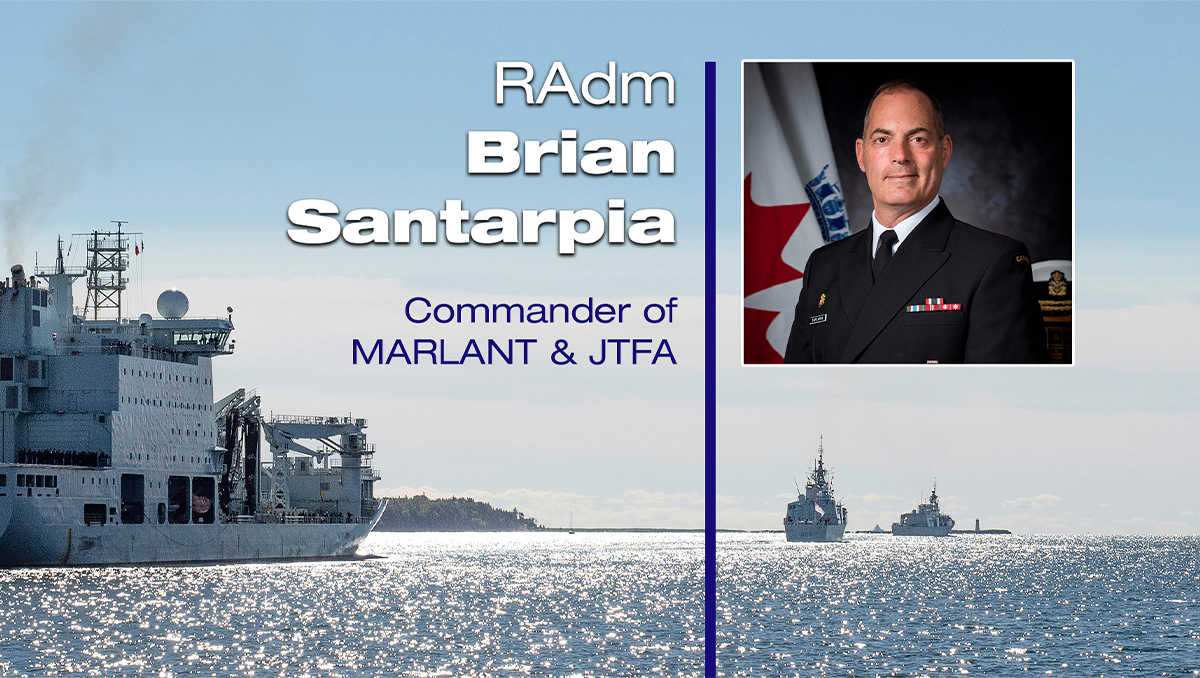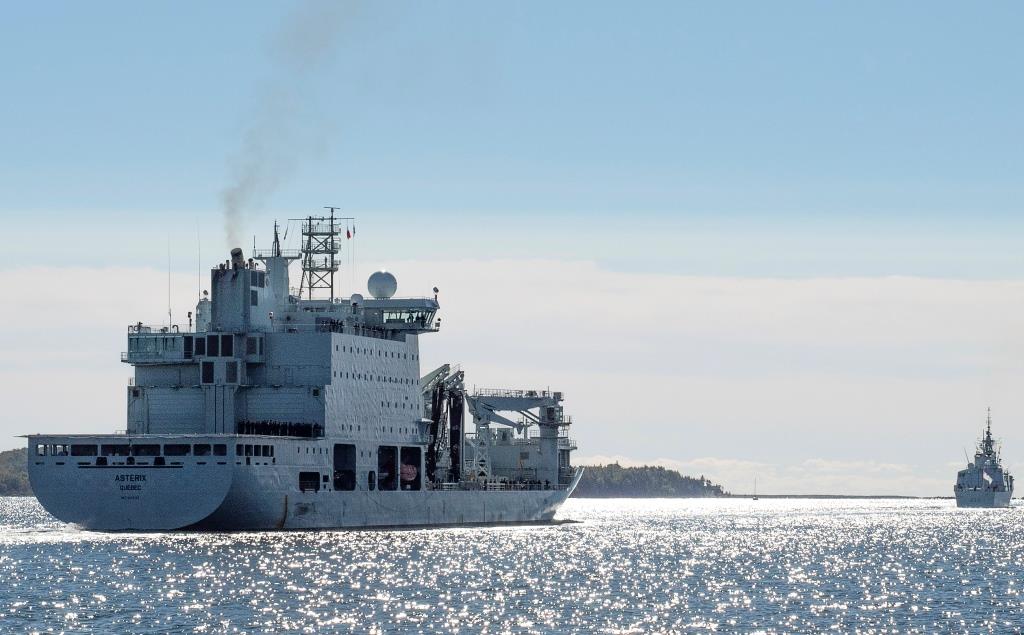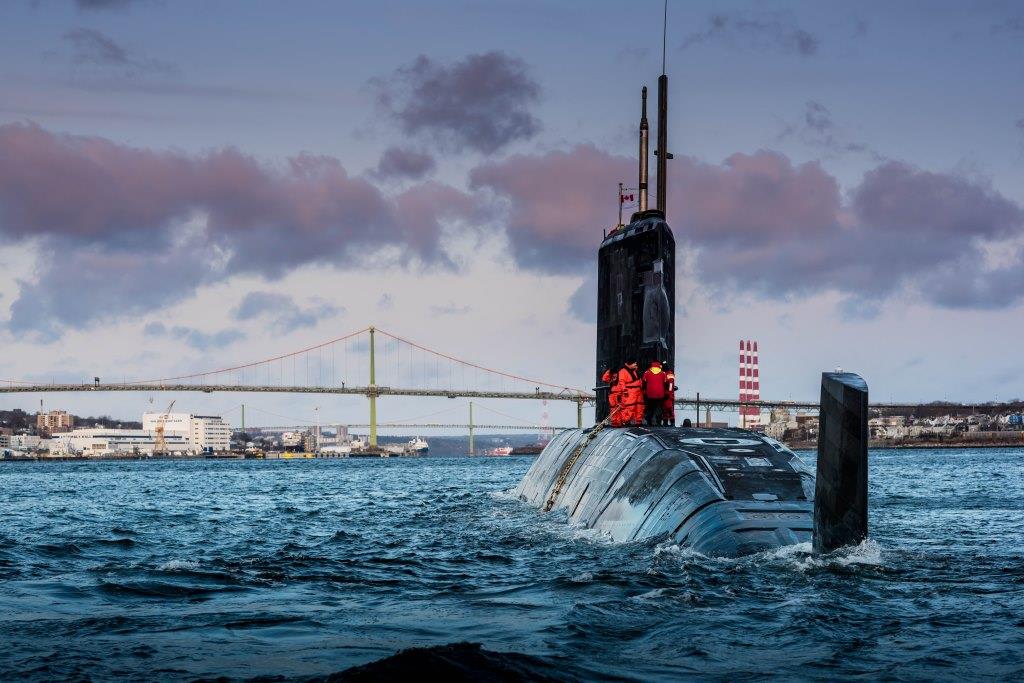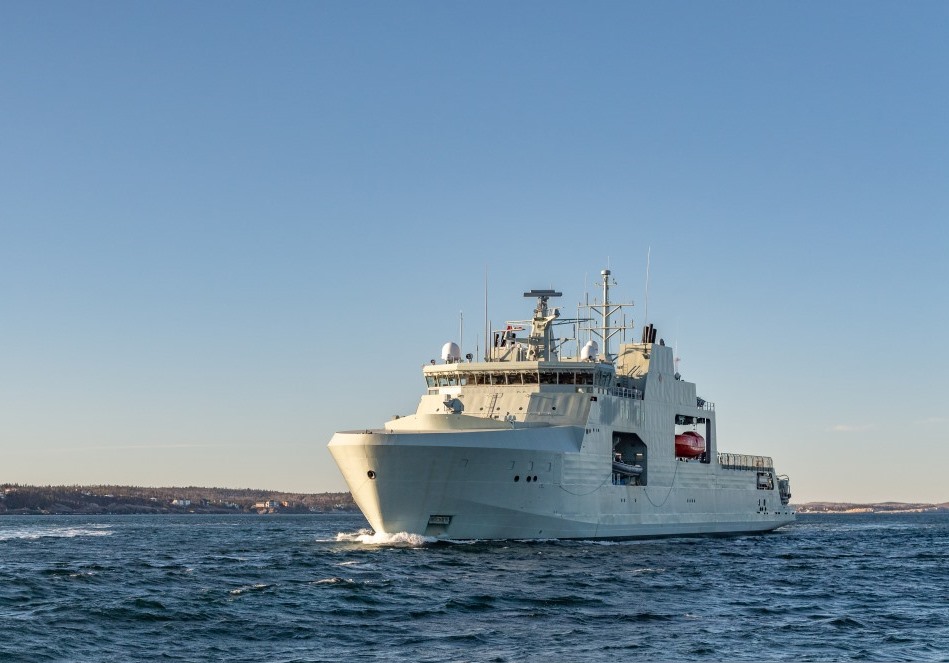ATLANTIC CANADA
REAR ADMIRAL BRIAN SANTARPIA
Commander of MARLANT & JTFA
CDR recently sent Halifax Correspondent, Jay Heisler, to talk to the newly installed naval commander on Canada’s East Coast. Santarpia took over as Commander of MARLANT & JTFA on July 27. Here is that discussion.
 RAdm Brian Santarpia took over from RAdm Craig Baines, who was posted to Ottawa as Deputy Vice Chief of the Defence Staff, on July 27 of this year.
RAdm Brian Santarpia took over from RAdm Craig Baines, who was posted to Ottawa as Deputy Vice Chief of the Defence Staff, on July 27 of this year.
The Commander of MARLANT and JTFA is responsible for the RCN on the East Coast, as well as for conducting routine and contingency domestic operations within the Atlantic area of responsibility. In accepting his new position, Santarpia said, “It is a great honour to be the next Commander of MARLANT and JTFA. I recognize that I am taking over an extremely professional team of sailors, soldiers, aviators and civilians who are committed to serving Canada. Working together we will continue to meet the day-to-day operational requirements of the Atlantic region while promoting the vital role of the RCN both at home and abroad.”
RAdm Santarpia enrolled in the Canadian Forces Officer Candidate Training Plan as a Maritime Surface Officer in 1986. His operational postings on both the East and West Coasts of Canada included Navigating Officer of Her Majesty’s Canadian Ships (HMCS) Cormorant and Vancouver, Combat Officer of HMCS Huron, Executive Officer of HMC Ships Chaleur and Halifax, and Commanding Officer of HMCS St. John’s.
He was Navigation Instructor at the Naval Officer Training Centre, Head of the Warfare Training Division at Canadian Forces Fleet School (Esquimalt), Operations Officer at Sea Training Pacific, and Commanding Officer of Sea Training Atlantic.
Following his promotion to Captain (Navy) in 2009, he was appointed as a Special Advisor to the Vice Chief of Defence Staff. In 2010, he was appointed Base Commander of CFB Halifax until his departure to attend the National Security Program in 2012.
Promoted to Commodore in July 2013, he was appointed Director General Naval Personnel. He led the transformation of that organization and assumed the duties of the first Director General Navy Strategic Readiness in April 2014.
From December 2014 to April 2015, then Cmdre Santarpia deployed to Bahrain to command Combined Task Force 150, a multinational group of ships and aircraft conducting counter-terrorism operations. Upon his return to Canada, he was appointed as Chief of Staff to the Vice Chief of Defence Staff, and later appointed Director General Plans at the Strategic Joint Staff in July 2016.
In May 2018, he joined the Canadian Joint Operations Command as the Chief of Staff.
CDR: Vice Admiral McDonald has told CDR that the new JSS ship is expected to be operational in early 2023. How will this impact naval ops in the Atlantic?
Santarpia: The JSS is going to be really important to us. The key to that ship is how it enables our other operations. A ship like that just makes much more effective any operation that you’re doing... It will also be able to support operations ashore. It will also be really useful for events where we do operations ship to shore. Like humanitarian missions, a response to a hurricane, or something like that.
MV ASTERIX IS A GREAT CAPABILITY
CDR: Tell us about how MV Asterix has performed as an interim solution? Would you prefer to have an additional Resolve Class ship so there would be one for each coast?
Santarpia: The Asterix has been great. It’s a great capability and I think we really need it. It’s so important that we not lose that capability, that we keep our sailors proficient. Asterix has done a great job and we like using Asterix. It’s a good ship. Would we like more? I’m a simple sailor and so more ships is better than less ships. More capability is better than less capability.
We have to balance all of the needs of the Canadian Forces against all of the needs of the government of Canada, and the decisions of how many of a particular platform we get, those are complex decisions. If you were asking this simple sailor, sure we would like more of those ships and that capability has been really good.
CDR: How have you been using the Victoria Class submarine capability here on the East Coast?
Santarpia: The Victoria Class submarine has been excellent. In 2018 we had two operational deployments, one for each coast. That submarine from this coast went over to Europe and was working with the ships that was part of Operation Reassurance with the NATO force. That submarine brings an incredible capability to moderate other submarines, to control strategic assets.
It’s capable of doing really interesting work in the counter-narcotics base down in the Caribbean, and so this submarine has been used in Operation Caribbe where it provides incredible support against the threat of drug smuggling. Overall it’s been a really good platform.
CDR: What new capabilities are you looking for in the new CSC warship?
Santarpia: The CSC is a great project and we’re very excited about how it’s progressing. It’s not so much that this ship is bringing new capabilities, what that ship is doing, and this is interesting, is that ship is going to combine the capabilities of the frigates we have now with the destroyers that we had before… It’s replacing two classes of ship and that’s why there’s 15 of them. It’s not bringing new capabilities to Canada, what it’s doing is replacing the old capabilities with updated and modernized equipment.
CDR: What is the timeline for starting to think about training for CSC as you transition out of the Halifax-Class?
Santarpia: I was the navigator of the second Halifax class, Vancouver, and we trained the sailors for that ship about three years before we had that ship. I can imagine we’re on a similar timeline… At this point it’s all pretty conceptual.
ARCTIC TRIALS FOR FIRST AOPS SHIP
CDR: How do you expect to be employing the AOPS ships?
Santarpia: She goes out and starts doing trials this year. While she’s doing trials, she’ll do trials in Canada’s north and then next year through the Arctic, and then down in the Caribbean. She’s be doing sovereignty-type patrols, and supporting science up in the north. She’ll be available for operations around North America, such as Operation Caribbe, she can be a great platform for that. If Canada responds to a natural disaster anywhere in the world, she’ll have the capacity for that kind of work. She’s going to turn out to be a really flexible platform that will bring all sorts of abilities for Canada to conduct operations around the world.
CDR: Please tell us about staffing levels and the ratio of Reserve Force to Regular Navy?
Santarpia: In the entire Navy, we’re about 15,000 people of which 8100 are regular officers and 3700 are reserves. And the rest of the people are civilian employees. The reserves are almost half the size of the regular force. Any given platform is done specifically on availability of the reserves. A lot of reserves work Class A. They will work from their home units for one night a week usually and then one or two weekends a month, so they would be available to go out in the ships regularly. On any given ship the ratio, it depends.
COPING WITH COVID-19
CDR: How has the current pandemic situation impacted naval operations?
Santarpia: The pandemic, it was very important for the Navy and the Canadian Forces to treat this as a national emergency, which we did. In March we got an order to prioritize protecting the force first and being ready to respond to whatever Canada needed in terms of responding to the pandemic. We slowed down our operations around the world to only those operations that were essential. And so some of the discretionary activities, where we would put sailors at a higher risk, we deferred.
So, for instance, we had ships that were going over to Africa to get involved with some capacity building, we turned that off and brought those ships home. As we got a hold of the pandemic situation here in Canada we’ve begun what we call business resumption because we know that we need to keep doing things like maintenance, training of sailors, in order to keep producing ships over the long term, and we also need to keep doing operations all over the world,.
We never stopped doing certain operations like Operation Reassurance, and this year we sent three ships north to Operation Nanook. We sent two ships off to do exercise Rimpac, that’s Winnipeg and Regina and the West Coast. And then Winnipeg will carry on from there to do Operation Neon off the coast of Korea. And so operations are continuing. We’ve figured out how to work in a COVID environment to see how we can keep doing training, keep doing maintenance and keep doing operations.
APPLY ON LINE TO JOIN THE NAVY
CDR: The Army reports some recruiting challenges. Are there recruiting challenges for the Navy in Atlantic Canada?
Santarpia: Yeah absolutely. All across the forces we couldn’t do recruiting in the same way because the recruiting centers were closed up as a response to COVID-19 initially. They’re beginning to open up through business resumption and you can still apply online but our capacity to put people through basic training was reduced. Currently we’re trying to target the trades that are short of sailors.
Jay Heisler is CDR’s Halifax Correspondent

